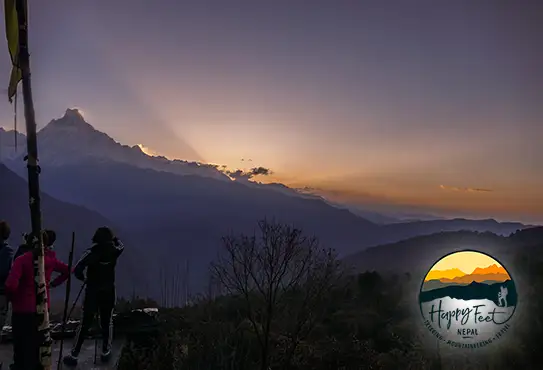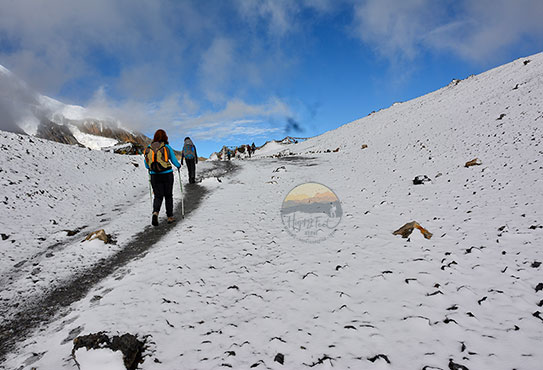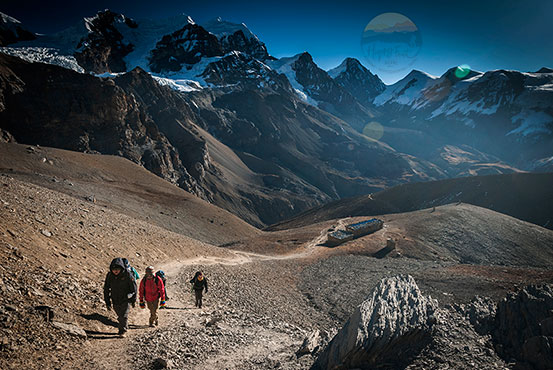-
Sunday - Friday: 9 AM - 4 PM
Annapurna Base Camp Trek is one of the great walks of Nepal through the deep gorges drilled by the glaciers of Annapurna.
Annapurna Base Camp trek also called the ABC trek or the Annapurna Sanctuary trek, is the second most visited and admired trekking destination in the Annapurna Region. In addition, there are several short trekking destinations with endless Panorama of the Annapurna Himalayas. Enjoy a great offer!
Highlights:
One of the great walks of Nepal, reaching the Amphitheatre of the Annapurna Mountains. Visit the cultural villages of the Gurung people and learn about them. Enjoy the grand sceneries of the entire Annapurna range. Visit Pokhara City, one of the most beautiful destinations in Nepal. Visit seven UNESCO World Heritage sites of Kathmandu.
Annapurna Sanctuary Trek, or the Annapurna Base Camp trek, is the second most visited and admired trekking destination in the Annapurna Region. There are several short trekking destinations with an endless Panorama of the Annapurna Himalayas. Still, the Annapurna Sanctuary or Annapurna Base Camp trek is amongst the shortest treks that take you into an arena of the massive Himalayas. The great walking to Annapurna Sanctuary starts with a short drive from Pokhara and ends at Pokhara with a short drive, but there are the options of starting and ending from and to Pokhara city itself. The trek begins walking through the cultural villages of Dhampus, Landruk, and Chhomrong and ends at Ghandruk. Most ethnic groups encountered on the trail are Chhetris, brahmans and mainly the Gurung with Trans-Himalaya Culture. The Annapurna Sanctuary trek can be combined or extended with Ghorepani Trek, Khayer or Khopra and Ghorepani Trek, or Mardi Himal Trek; all these sites are the most scenic sites on the southwestern face of the Annapurna massif.
Arrive in Kathmandu, clear customs and immigration formalities, and claim your baggage, which takes some time. Upon arrival, receive a traditional welcome from a Happy Feet Mountaineers representative, then transfer to the hotel. Arrive at the hotel, and the rest of the day is free, with optional excursions (not included), or you can ask to organize any of the tours or stroll through its vibrant streets.
Kathmandu, the capital and heart of the country, is home to three medieval cities that symbolize everything in Nepal. Having lived through several Buddhist and Hindu ruling dynasties, the culture and society of Kathmandu Valley have evolved to give it more than just a unique feature. Today, it is an urban city, still rapidly growing, with its ancient myths and testimony to the greatness of the people who have lived there for time immemorial.
Breakfast at the hotel. In the morning, visit Swayambhunath, located on a lovely little hill to the northwest of the city centre, which is the most sacred Buddhist site. The self-originated shrine is believed to have been built in its current form around 250 B.C. The stupa, painted with a pair of the Buddha’s all-seeing eyes, stands on a lotus mandala base on all four sides. The site offers a complete view of Kathmandu Valley, its surroundings, and the Himalayas to the northeast.
In continuation, drive to Patan, one of the three medieval cities of Kathmandu valley and one of the World Heritage sites among the seven World Heritage sites of Kathmandu valley, located 7 kilometres south-west of Kathmandu. The city of Lalitpur, the City of Arts, was a renowned Buddhist centre in Asia, with four Ashok-built stupas and a multitude of miniature stupas, monasteries, viharas, and temples. At Patan, we visit its Durbar Square, the Golden Temple, Thousand Buddha, and its museum, among other sites, which explain Buddhism and Hinduism in extensive labels within the living traditions and context.
In the evening, visit Durbar Square in Kathmandu, an example of the urban architecture of the Malla dynasty, with 19-storey buildings, temples and palaces, and the residence of the living goddess Kumari. Kathmandu Durbar Square, the old palace complex that houses a mass of temples and palaces, including the Gaddi Baithak Durbar, constructed in 1908; the Basantapur Durbar, or the old Royal Palace; and the Kumari Chowk, the residence of the Living Goddess. Basantapur is amongst the most attractive sites in the bustling centre of Kathmandu, and a western traveller around two hundred years ago wrote that there were more temples than houses and idols than people in its city. Lying at the heart of Kathmandu, Durbar Square is a UNESCO World Heritage Site and a must-see. The individual buildings, palaces, and temples feature intricately carved doors, lattice windows, and struts adorned with mythic and erotic figures.
Finalise with a tour and a rickshaw ride through the old city market centre, the Ason Bazaar, seeing what the Nepalese people buy and sell in their daily lives.
A 6-hour sightseeing drive.
Breakfast at the hotel in Kathmandu and start an overland journey toward the beautiful Pokhara city. The driving takes you through an exciting countryside overlooking mountains, hills, and scattered villages until we reach Pokhara—Mount Annapurna, Machhapuchhre and Lamjung rim the northeastern horizons of Pokhara City. Or take a 30-minute scenic flight from Kathmandu to Pokhara and start the excursions the same day (flight supplement 60$ not included).
A 30-minute drive and a 5-hour trek.
Breakfast at the hotel and take an exciting drive to Phedi, the flat river valley floor below the far to the base of Dhampus village. Leave the car at Phedi and start the trek with steep contouring for an hour to reach the Dhampus villages. The trail passes a charming cultivated area requiring crossing a dirt road. Looking back to Naudanda, Sarangkot and the lower valley are beautiful. The main Dhampus village is set on a wide valley sloping to the east with a beautiful view of Fishtail, Annapurna, Lamjung and Manaslu far behind. The settlement of the Dhampus area is home to Brahmans, Chhetris and a few Gurungs. Enjoy fantastic sceneries from Dhampus’s viewpoint at 1700m. Continue passing several lodges, a School, a permit checking post, and Potana with a gradual climb through a lovely forest area with grazing meadows and grand views in front.
Potana, a famous night stopping place for trekking to and from Annapurna base camp, lies on a hilltop with a collection of Lodges and offers a grad scenery of Machhapuchhre (Fishtailed Mountain), Annapurna and Lamjung Himal range and villages of Dhampus and Pokhara. Finally, a lovely short walk through a rhododendron forest ridgeline reaches Deurali, a trail junction leading to Annapurna Base Camp and Mardi Himal. It is an excellent place to rest with tea and enjoy the views of Annapurna South, Hiunchuli, Pokhara and Phewa Lake.
Then a steep descent through the forest to Bedi Kharka (Shepherders’ camp) and cross a stream, and traverse Tolka with views of Bichok Gurung village, Ghandruk and all the villages dispersed on the mountain slope across the Modi valley.
A 5-hour trek.
Breakfast at the Lodge and start the walk of the second day. A short descent on a staircase then crosses a suspension bridge and a ridge through a forest. A level trail past streams, occasional settlements, and cultivated fields and cross a bridge arriving at Landruk village. The views across the Modi River are Ghandruk village, Annapurna South and Hiunchuli. Landruk is one of the principal villages of the Gurung people, and it is one of the famous junctions for a night stop and trekking trail branching toward Ghandruk, Annapurna Base camp and Mardi Himal.
About five minutes from Landruk, a trail junction to Ghandruk and Chhomrong is reached. We take the right fork to Chhomrong, enjoying the fine views of Annapurna South, crossing two wooden bridges and crossing a bridge to Himal Qu/Naya Pool (due to the New Bridge built here) at 1410m, and continue on a steep climb to Jhinu Danda at 1750m—a late but lovely lunch place with some lodge. There is a hot spring far below the Jhinu Danda, and people who arrive here for an overnight stop visit and take a natural hot water bath.
In the afternoon, continue on a steep climb passing occasional teahouses along a naked ridge and reach a trail Junction to Ghandruk and Annapurna Basecamp. A short walk to the northeast, we are at the upper part of Chhomrong with views of Chhomrong villages, Fishtail Mountain, Annapurna South and Hiunchuli and its glacier. Chhomrong is the highest and the last permanent village on the trek to Annapurna Base Camp.
A 4-hour trek.
Breakfast at the Lodge and start the trek with a descent of about 200m on a stone staircase, cross the Chhomrong Khola, and begin ascending the side valley via the settlement of Tilche, through forests of bamboo rhododendron and oak. Climbing on a rocky trail brings us to Bhanuwa, which leads a one-hour descent to a lodge named after Sherpa and climbs Sinuwa2340m, our lunch place. In the afternoon, the trail leads another hour’s going up through orchid and rhododendron forest to Khuldi/Kuldi 2470m seeing the lodges of Bamboo and Doban below. Finally, steep descent over a slippery stone staircase through dense bamboo and rhododendron forests to Bamboo Lodge, with several Lodgesinto the narrow valley.
A 5-hour trek.
The trail ascends through a side of a canyon valley into bamboo and rhododendron forest with occasional short descents. The area is a favourite of black-faced langur, and we may encounter them in families and groups. After traversing some avalanche trails, we reach Doban2500m. It is just an hour’s walk, but the area is complex if you encounter snow and require crossing some avalanche section. Therefore, we do not recommend the Annapurna Base Camp Trek from December till mid-March.
Further, continue crossing a stream, avalanche point, and a landslide to Baraha Than Temple, the boundary forbidding carrying eggs or meat beyond this point. Continuing past a cascade, another temple with tridents reaches Himalaya Lodge in a deep gorge, where we stop for lunch. In the afternoon, pass a rocky forest trail and climb through a deep narrow-gorge to Hinku Cave, a cave shelter with a small lodge under a huge overhanging rock. Then cross a major avalanche point and reach Deurali (Deurali means a ridge/hill saddle to cross another valley)
A 3-hour trek.
From Deurali, the valley widens with a level walk, and the mountains that circle the Annapurna Sanctuary start appearing. The avalanche crashing point of Hiunchuli and Annapurna South lies high above the Deurali but is not visible. From Deurali, there are two trails, and we take the longer one to avoid the dangerous avalanche area. The trail passes through a mix of bamboo and birch and crosses a bridge at Bagar to rejoin the main path. Still, we need to cross some avalanche points, descend to a stream, and reach Machhapuchhre Base Camp; the famously known short form is MBC. The site offers grand sceneries of Hiunchuli, Annapurna South, Annapurna I, III (7555m), Gangapurna 7454m and Machhapuchhare.
A 2-hour trek.
Today, we take a short panoramic trail to Annapurna Base Camp, following a stream and passing shepherds’ huts. The Sheepherders’’ of Chhomrong, Ghandruk, Landruk and Bichok graze their sheep herds here in the summer. Staying close to a lateral moraine, we reach the Annapurna Base Camp enjoying the deceptive views. The most imposing is the south face of Annapurna to the northwest, but we are circled by giant mountains, confusing us in the direction from where we entered here! The Annapurna Sanctuary also offers some small trekking peaks, such as Tharpu Chuli, also called Tent Peak, of 5663m, a permit is not required, and it provides a 360-degree view of the entire Annapurna sanctuary. The other two trekking peaks are quite challenging; they are Singu Chuli, also called Fluted Peak of 6501m and Huinchuli. The Himalayan Tahr, with imposing manes, grazes around their Sanctuary.
Check into a lodge, have lunch, and climb high above in the afternoon for better acclimatisation and a night of comfortable sleep and enjoy the views that many trekkers here miss!
A 6-hour trek.
Breakfast at the hotel, say bye-bye to the Annapurna Sanctuary and walk down to Machhapuchhre Base Camp, Deurali, Himalayan Lodge, and Doban. We climb up, gasping, in three days and trek down singing in a single day!
A 6-hour trek.
Retrace to bamboo, climb to Khuldi/Kuldi, pass Sinuwa, descend to Chhomrong Khola and pass through Chhomrong village to Upper Chhomrong, climbing on the same stone staircase you walked down.
A 4-hour trek and a 2-hour drive.
A short traverse to the trail junction leading to Jhinu Danda, climb to a landslide and reach another trail junction to Ghurjung and Tadapani, leading to Ghorepani Trek. From here, we descend through forests to the Kimrong Valley floor, with a beautiful sight. Cross the Kimrong bridge and contour up to Kumrong Danda at 2225m, a beautiful ridge with views of Machhapuchhre, Annapurna and Ghandruk village, where we will rest and enjoy lunch. In the afternoon, we descend to Old Ghandruk village and traverse through the settlement seeing their gracious traditional buildings (slowly disappearing – a curse of modernisation) and reach the end of the Ghandruk village, branching the trail to Ghorepani via Tadapani, to Landruk and Birethanti. After about 15 minutes walk from the Ghandruk village, we catch our Jeep and take a scenic drive to Pokhara. The Jeep Road follows the Modi Khola valley to Birethanti and then to Naudanda, and back to Pokhara via Sarangkot, enjoying a beautiful view of Pokhara city, Peace Stupa, and of course, the grand mountains to the northeastern horizon.
A leisurely breakfast and a boat ride to cross the Phewa Lake to visit the Peace Stupa, a Buddhist monument dedicated to World Peace, above a beautiful hill facing Annapurna, Phewa Lake and Pokhara City. Visit the stupa, admire the views, and drive to the International Mountain Museum. Visit the museum, David’s Fall and Tibetan refugee camps and go to The Fishtail Lodge for a late lunch, enjoying the grandeur setting of nature. The rest of the afternoon is free to enjoy on your own.
Early in the morning, we take a short drive to Sarangkot viewpoint to view the best panoramas Pokhara City offers. The views from the top of Sarangkot offer a 360-degree panorama, including the Phewa Lake, Pokhara city and its surroundings, rimmed by grand snow-capped Himalayas and rolling hills as far as we can see. Then return to your hotel and have breakfast. Finally, in continuity, drive to the airport for a 30-minutes flight to Kathmandu.
Get landed at Kathmandu airport and greeted by the Happy Feet Mountaineers representative, and drive to your hotel in Thamel, which may take 20 to 40 minutes, depending on the traffic. The rest of the afternoon is free.
Breakfast at the hotel and drive to Pashupatinath Temple. A pagoda Hindu temple with gilt roofs, carved with silver doors dedicated to Lord Shiva, situated at the bank of the holy Bagmati River, and regarded as among the most sacred temples of the Hindu religion, Pashupatinath is the focus of pilgrimages culminating on the day of Shiva Ratri (the marriage anniversary of Lord Shiva and the goddess Parvati). Pashupati is also the cremation ground in the ghats (cremation group) along the bank of the River Bagmati, where the recently deceased Hindus of the Valley are cremated.
Then take a 13-kilometre drive to Bhaktapur, east of Kathmandu. Its original name is Bhadgaon, or the village of Devotees, which is one of the living museums of Kathmandu Valley. Bhaktapur is filled with the 55-windowed Royal Palace, the Palace of the Kumari, the temple of Taleju, the temple of Pashupati, the main square of Taumadhi Tole, Nyatapola Temple (the most imposing and tallest such architecture in all of Nepal), the temple of Akash Bhairab (the second most important temple of Bhadgaon), the Dha Hateya and the Square of the Potters. UNESCO recognises Bhaktapur as a World Heritage Site.
In the evening, visit the Boudhanath, the largest Buddhist shrine in the Kathmandu Valley. This ancient Chorten was built in the 5th century A.D. by King Manadeva. A series of three terraces leads up through water, fire and air segments to the pinnacle, symbolic of space and the highest spiritual attainment. The whole is surrounded by a circle of shops which form a small Tibet. Lord Buddha’s four pairs of eyes flash vividly in the cardinal directions, radiating the message of Mahayana Buddhism, known as Lamaism in Sikkim, Ladakh, Bhutan and Tibet.
Breakfast and the rest of the day are leisure on your own. The Representative of Happy Feet Nepal will arrive at your hotel with transport three hours before your departure flight time. Get escorted from the hotel to the International Departure Terminal, see off formalities, and go through the immigration and departure.
Mid-March to June, the forest remains in bloom with multi-coloured rhododendron, magnolia, and wild orchids and is full of birds. Or from the first week of October to the end of November when the weather remains crystal clear day and night. August-September is the best month to enjoy the luxuriant rainforest full of greenery and to sight the rare highland flowers. The Months of December to early March are not recommendable for trekking in the Annapurna Sanctuary. The Dobhan to Machhapuchhre base camp area can be life-taking in the above months.


